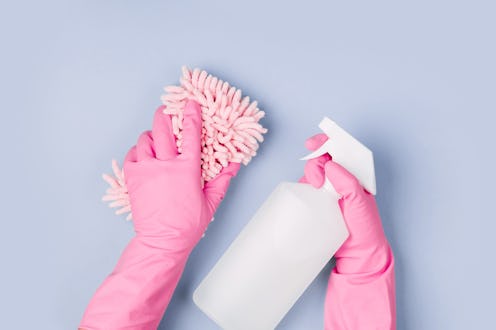(Living)
Doctors Share The Unexpected — But Totally Genius — Place To Use Lysol At Home

These days you've probably kicked your cleaning practices up a few notches, which might mean switching up some of your usual products. And if that's the case the CDC and the EPA have some recommendations. The latter of these, in particular, recently approved the use of two Lysol disinfectants for fighting off COVID-19, and it turns out you may be able to use them in more ways than you think. In fact, with a few doctor-approved Lysol spray hacks, you could feel exponentially cleaner and safer at home — or wherever you're staying.
Earlier this month, the EPA announced that both Lysol’s Disinfectant Spray and Disinfectant Max Cover Mist had been proven to kill SARS-CoV-2, the virus that causes COVID-19. In fact, they have a 99.9 percent rate of effectiveness and work within just two minutes of contact. While these tests were conducted while using the products specifically to disinfect hard, non-porous surfaces — like some kitchen and bathroom counters, tabletops, and desks — there may be a few other places in your home to try them, according to some medical professionals.
But before you go wild spraying everything in sight, there are some precautions to keep in mind when cleaning and disinfecting with Lysol. For one, keep it away from your skin, eyes, and mouth. "Lysol was never designed to be sprayed on your body and the company warns against doing so," explains Dr. Leann Poston, a licensed physician and content contributor for Invigor Medical. "Take care not to get Lysol in your eyes, inhale it, let it come in contact with your skin, or swallow it." To help keep your skin safe, use a pair of gloves whenever you're spritzing something down.
Additionally, make sure there's good air flow wherever you're using Lysol. "So far in 2020, exposure via inhalation seems to be the biggest problem, according to poison control centers, so make sure you are in a well ventilated area when using the spray and leave the room after using it if possible until it dries," shares Dr. Maria Vila.
With those measures in mind, it's time to start cleaning. Ahead, find a few hacks for using Lysol in your home — from those you may have already been practicing to ones you probably never never saw coming. And this probably goes without saying, but always heed the product directions first and foremost.
Lysol Spray Hack: Hit Up Highly Touched Surfaces
Dr. Poston suggests first zeroing in on the most highly touched places in your home, like door handles, light switches, remote controls, phones, and phone chargers.
Lysol Spray Hack: Tackle Your Toilet Bowl
"If you run out of toilet bowl cleaner, Lysol can be used to disinfect the toilet," says Dr. Poston, who mentions that this could be a substitute when you don't have bleach handy. "Bleach tends to work better for this use as it is more effective against the hardy bacteria found in the gastrointestinal tract."
In addition to its ability to kill SARS-CoV-2, Lysol is great to use in the bathroom because of its effectiveness against mold. But Dr. Villa mentions that when using these sprays in your shower or tub, be sure to rinse with water before stepping in, as to avoid skin irritation.
Lysol Spray Hack: Give The Carpets A Coat
"[You] can use Lysol spray on fabric according to their website, so this is a great way to sanitize and disinfect your living room," says Dr. Vila. For sofas, curtains, or carpets, she recommends first dusting and removing dirt and debris with a vacuum before spraying them down, and then waiting for the area to dry before making direct contact. Additionally, Dr. Poston recommends testing a small, discreet area first to check for color-safeness.
Lysol Spray Hack: Spray Your Shoes
Stop the virus from setting foot (pun intended) in your home by using Lysol on your shoes when you step inside. "After the debris is removed you can spray the bottom of your shoes with Lysol to decrease the number of bacteria and viruses carried into the home," says Dr. Poston.
This article was originally published on